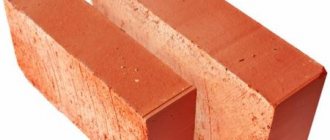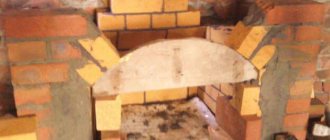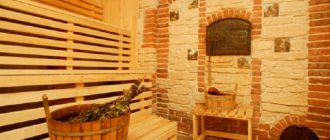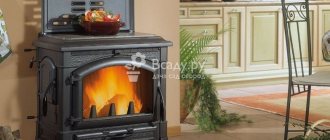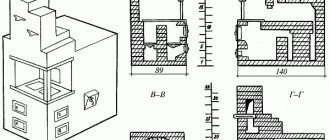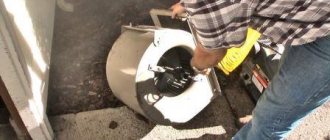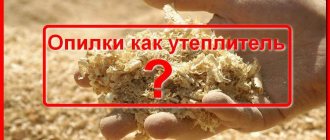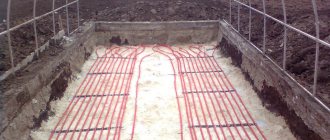What to heat with?
A potbelly stove is efficient and small-sized, does not require special knowledge for its operation, installation is not complicated, and even a person who has never done this can handle the kindling. Unfortunately, not everyone can accurately answer the question: “What to heat with?” In principle, a potbelly stove is not much different from an ordinary stove and therefore can use the same types of fuel, namely:
- the most popular are firewood;
- in the second place you can place coal;
- sawdust;
- peat;
- and even oil.
What to use besides firewood?
Yes, firewood undoubtedly occupies a leading position in use, but other types of fuel can also be used:
Coal
- Coal, like firewood, is popular, but due to the fact that it is more expensive and not everyone can afford it, it is used less often. Although in terms of indicators it is higher than firewood. For example, coal burns longer and produces a high temperature, which means it has a high efficiency index. But it is precisely because of the increased heat that the chimney needs to be reworked.
Peat in briquettes
- Peat, as well as sawdust, have one significant drawback - they require special storage conditions. Under no circumstances should briquettes be allowed to get wet, otherwise they will lose some of their properties and, in some cases, will not be able to burn. After the briquettes burn out, quite a bit of waste from their use remains in the ash pit, and during the combustion process an unpleasant odor is released.
Pellets
- Pellets – or in other words pressed sawdust. It would seem that the benefit is obvious, you can heat a stove from production waste, but unfortunately the price is not much less than firewood.
What can't you heat?
It is strictly prohibited to use liquid fuel in residential premises. This type is fire and explosive. In addition, after using it, it is necessary to clean the chimney more often, since due to the mixing of condensate and soot, a black tarry mass is formed, which is difficult to clean off. Even if you use liquid fuel in industrial premises or cabins, you must have good exhaust and good air circulation. Otherwise, burning mass may be released into the room.
Coal as a fossil fuel
Coal is a type of fossil fuel. The process of its formation occurs from ancient plants deep underground without access to oxygen, for quite a long time. Coal rock is, first of all, carbon containing non-combustible impurities. Coal is generally classified as follows:
- Lignite is the lowest age type of coal, has a brown color, up to 45% moisture content, high sulfur content, and is the most friable compared to other types of coal. Mainly used in power plants.
- Brown coal is also a fairly young type of solid fossil. Carbon content up to 70%, humidity about 40%, volatile substances 38-50%. It is used as local fuel, sometimes as a chemical raw material.
- Coal is a sedimentary rock formed as a result of the decomposition of plant remains. Here the composition is more saturated with carbon (from 75% to 95%) and contains less water (8-20%) and impurities that form ash.
- Anthracite is coal of the most ancient origin, has high density and shine. Carbon content 95%. Solid fuel from such coal does not ignite well, having the highest calorific value.
How to properly heat a potbelly stove?
Before you start melting, you need to take care of fire safety. If the house is made of wood, then several options are possible. For example, asbestos-cement tiles, or just a brick cabinet or metal sheet protection, must be laid on the floor.
Advice! By installing shielding elements, an obstacle is created to prevent coal or wood chips from accidentally flying out of the firebox.
Tips on how to properly heat a potbelly stove:
Cleaning the potbelly stove firebox
- Before starting stoker work, you need to clean the ash pan from combustion products and the grate from accidentally remaining unburned firebrands. Thanks to this, it will be possible to achieve normal air circulation, as a result of which the logs will burn much better and give off more heat.
- After completing the first stage of preparation, we move on to laying firewood. Laying firewood is a fairly simple process at first glance, but without knowledge of the combustion features of stoves and a little experience, it may not work the first time. It is necessary to stack the firewood in such a way that there is enough space for air exchange. If everything is done correctly, the fuel will burn out completely.
- Laying is done in a cellular or row manner.
- When laying firewood, you should maintain a distance of 1 cm from each other, and the height of the stack should be such that it does not reach the top of the chamber by about 10 cm.
- Following these recommendations will increase efficiency.
- After the firewood is stacked, you need to take care of the ignition. For these purposes you will need dry wood chips or paper. They need to be placed between the rows.
Attention! Never use flammable materials to light stoves. This can lead to serious consequences.
Properly stacked firewood burns evenly. Try to do this strictly in the center.
Coal
Is it possible to heat a potbelly stove with coal? It is worth remembering that coal may not be the main type of fuel in all cases. This is because the temperature generated during combustion is high, and not every stove can survive this. And now about the process of firing a potbelly stove.
Place paper and wood chips on the bottom and light it. After the wood chips have ignited, firewood is added and as soon as the logs burn out completely, coal is thrown in a layer of 10-15 cm. When the coal flares up sufficiently, the last portion is added. If necessary, you can add more, but only after the coal has completely burned out.
Firewood
How to heat a stove-stove with wood? A process that does not require special knowledge. As soon as you have finished lighting the potbelly stove with wood, all that remains is to monitor the temperature of the stove and add logs.
Attention! To avoid cracks, it is necessary to maintain the furnace in one temperature pore. If frequent changes from cold to hot occur, the oven may collapse.
Unfortunately, it is impossible to heat around the clock. You want to sleep at night, but winter is unlikely to provide such an opportunity, otherwise you will wake up in a cold room in the morning.
After several days of heating, a lot of waste accumulates in the ash pan and must be removed in a timely manner. The process is carried out using an iron scoop.
Other fuels
Heating with other types of fuel must be done in the same way as when heating with wood and coal. Pellets are placed in the firebox according to the principle of coal, in gradual portions, and briquettes, like firewood, leaving small gaps.
Advice! Don't forget about the blower door. It must be kept slightly open at all times, otherwise smoke may escape into the room.
Since pellets and briquettes appeared relatively recently, a universal combustion method was not invented for them.
At first I almost burned the house down...
Until the age of 38, I was a city dweller, a completely apartment dweller. One day I got bored with this kind of life. I wanted a yard, a vegetable garden, a bathhouse, in general - change and space.
There was only one way out - to buy a house within the city limits. So I did. But the house I bought was not residential; the previous owners used it as a summer house. Wooden building 52 sq. m, stove heating: the house has a brick stove of the “Swedish” type, and the bathhouse has a homemade iron stove.
Due to some nuances, the re-registration of documents was delayed and it was not possible to supply gas in the first year. We had to heat ourselves with wood.
My first heating experience almost cost me my house. Unknowingly, I stuffed the compartment full of firewood, slipped kindling and paper down, and lit it. I opened the vent fully, the wood flared up, and I closed the valve halfway.
After about thirty minutes, the first armful burned out and I stuck the second one. Things are going well, the house has become warm, the door and the cast-iron stove are red-hot. But then I smelled smoke in the room. The pipe in the ceiling became hot and the sawdust that was placed there as insulation began to smolder.
I had to throw the wood out of the stove into a basin with a poker and throw it out into the street. And spill the ceiling in the pipe area with water. To do this, I climbed into the attic with buckets and caused a small flood there.
How to maintain a constant temperature?
After the fuel burns out, the cooling process begins and after some time, the stove cools down completely. In order not to use a large amount of fuel and maintain the temperature of the potbelly stove for as long as possible, knowledgeable craftsmen recommend following a few tips:
- Place a metal screen near the potbelly stove, at a distance no further than 5-6 cm. This technique allows you to retain some of the heat due to the reflective surface of the screen.
- If you build a brick jacket for a potbelly stove (lay it on the sides), the heat will be retained for a long time and fuel consumption will be noticeably reduced. Be sure to leave gaps for ventilation.
- You can also increase the burning time of the fuel by reducing the air supply. For example, in the case of firewood, it is necessary to stack them as close to each other as possible. And coal, you shouldn’t stir it up often. Only as needed.
- There is also a simple trick to keep the room warm for as long as possible. To do this, you need to place a bucket or tank of sand on the stove. The sand will transfer some of the heat into the room and some into the oven, thereby slowing down the cooling process.
How to heat a brick oven
In order for the wood to burn for a long time and optimally, it took some time to adapt. Of the species I use mainly birch, aspen and pine (rarely). I make sure that there is no rot - no matter how much it burns, it will not provide heat. The optimal fuel is dried, non-resinous firewood.
I make the first stack of 5–7 medium logs with kindling. It burns as intensely as possible. This is done so that the cold stove warms up and the draft reaches operating mode. When the first stack burns out and a few coals remain, I lay a second one - 4-5 large logs.
When they ignite, I begin adjusting the draft with the blower door. I make sure that the wood burns out as slowly as possible - I maintain a calm “straw” flame.
If the wood is damp, I increase the draft; when they are dry, I close the vent almost completely. Old stove makers say this: the stove should whisper, not howl. But this is learned in about a season of practice.
I practically don’t touch the damper of the pipe to regulate combustion - if it is partially closed to reduce draft, the chimney can become clogged with soot. I close it only when the wood is completely burned out.
But I also keep an eye on the smoke from the chimney - there shouldn’t be any smoke. If there is soot, it means the wood is not burning through, and you need to slightly increase the draft. If soot starts to appear, the chimney will clog quickly.
The number of firewood stacks for one fire depends on the outside temperature. I usually need no more than three. But here the house also plays a role: I insulated it well from the outside, thereby reducing heat loss.
How long can you heat continuously?
Several factors influence the duration of the fire:
- the house's ability to retain heat;
- what type of fuel is used;
- if heating is provided, then what kind;
- and finally the owner himself, and his preferences for indoor temperature.
If the winter is not very cold, then a house measuring 6x6 is enough to heat once a day, and the temperature will be within 20°C. For example, having lit the stove in the morning, the house will be hot (about 24°C), but by the next morning it will drop to about 18°C.
What types of stoves are there?
A potbelly stove is a simple design that has a compartment for firewood, an ash pit and a chimney.
To make the case, one of two metals is used:
- Cast iron.
- Steel.
Wood-burning cast iron stoves for a summer residence will have an impressive mass. Its heating takes a little longer than steel.
But inertia pays off when decay occurs. The steel walls are hot while the combustion process is going on, and then they cool down just as quickly. Cast iron retains heat for some time after extinguishing.
In addition, cast iron has a longer service life; such a stove will not burn out for a long time. But at the same time, it can be damaged, for example, by dropping it or hitting it with a heavy object - there is a possibility of cracks appearing and the device will become unusable.
Other differences in models. Potbelly stoves can be:
- With legs.
- Without legs, on a flat base.
The former look more elegant and are safer to use.
- rectangular;
- barrel-shaped.
Barrel-shaped potbelly stove
The latter are most often made with your own hands, for example, from a piece of pipe.
As for convenience, user reviews show that a rectangular shape is more suitable for firewood - it is much easier to place fuel in it.
Construction of a potbelly stove with a water circuit
A potbelly stove is the most common wood-burning stove, which is often used to heat a garage. Thanks to its simple design, this product has been incredibly popular in the domestic market for many years in a row. It can be made from any available material.
For example, an old iron barrel, a propane tank, or a regular iron box will work for this task.
The product operates as follows. Firewood is placed inside the stack of the unit and set on fire. During the combustion of wood, the iron body of the stove heats up, the heat from which is released into the surrounding space. A popular type of conventional stove is a stove with a water circuit.
Oven with water circuit.
It differs from the standard model in the presence of a water circuit, consisting of a pipe system, shut-off valves, an expansion tank, a heat exchanger, a pump, and several radiators.
To ensure a constant temperature in the garage in winter, the water in the heat exchanger is heated by igniting the stove. The heated liquid flows through pipelines to radiators, the heat from which escapes into the surrounding space.
Where does the cooled water go? By turning on the pump, it is pumped from the radiator to the heat exchanger, where it is subsequently heated.
That is, the essence of the operation of such a heating device is to heat the liquid to the evaporation temperature. Condensate washes the boiler from all sides and warms up the walls of the heating chamber. As a result, such heating works effectively due to the water jacket and the presence of several radiators.
Installing a stove in a country house
Before starting installation, you need to choose a suitable location for the stove. It must be remembered that it must be kept away from all foreign surfaces and objects. At the same time, her work must always be monitored, which means she must be in sight.
The legs of the potbelly stove are also made of metal and, accordingly, heat up to a high temperature.
It is necessary to install the stove on a non-flammable base, such as: concrete, ceramic tiles, brickwork, tin covering.
You cannot place a potbelly stove on linoleum, laminate, soft coverings, plank floors, parquet, or plastic. Chimney pipes must be installed without connections within the same room. If such work cannot be carried out, then the connection should be as tight as possible, the lower part of the pipe should “fit” into the upper. If pipes require passage through walls, then you need to equip a ceramic or brick thermal barrier . The fuel storage location should be at a safe distance from the stove.
Functional parameters of a potbelly stove
Potbelly stoves heat the room, but they can also be used to heat food. The flat top allows you to place pots and heat kettles; and a number of models are equipped with a “circle” burner.
Some stoves have decorative value. They are decorated with artistic casting and can have a glass door.
After loading fuel and igniting the fire, the intensity of combustion is regulated by opening and closing the ash drawer or the ash door.
If the horizontal section of a metal pipe (passing through a living space) is 3 meters, then its efficiency is 80% or more. This is a good indicator for such a simple design.
Advantages and disadvantages of a potbelly stove
A potbelly stove has a lot of advantages, the most important of which is efficiency , no fuel costs are required. The stove works great with any wood, sawdust, or wood chips, as long as they are dry enough to catch fire. This unit can be easily transported and food can be cooked on it without any problems if the potbelly stove model includes a hob on the top surface. This is an excellent option for a summer house that does not need to be heated every day; this unit can also be found at construction sites, in garages and other small spaces.
If you choose a stove in any style, it will also become a wonderful decoration and interior detail.
A potbelly stove made of stainless steel quickly heats up and cools down after use, this allows you to clear it of ash as soon as possible after extinguishing the fire.
This stove is durable and reliable; the materials from which it is made can easily withstand high temperatures and are not subject to destruction. The disadvantages of this stove include the fact that it can provide a favorable environment only in a small room. Using it in a cottage or large building will not bring good results. A cast iron unit tends to cool down for a long time after operation. During operation of the stove, the natural smell of burning wood . It is necessary to constantly monitor the operation of the stove and after it, until the potbelly stove has completely cooled down.
Features of using a potbelly stove in a garage
A potbelly stove is a small metal stove of simple design that runs on solid fuel.
The advantages of this method when heating a garage are:
- Low cost of the stove and fuel for it.
- Opportunity to make your own stove
- The potbelly stove is small in size, which allows it to be installed in a room with a small area.
- Minimum installation and maintenance costs.
- No foundation or capital pipe needed.
- You can cook or heat food on it.
- Quickly releases heat and effectively heats the room.
The disadvantages of such a stove may be:
- The need to create good ventilation in the room and relatively increased fuel consumption. This is due to the fact that the oven cannot accumulate heat.
- The walls of the housing are capable of giving off heat and heating the room while the unit is heating. When the fire stops, the walls of the stove cool down quickly and the garage does not heat up.
- To reduce fuel consumption, it is necessary to construct a stove of a special design, where the pipe is installed not on the back wall of the device, as in the simplest designs, but above the door located on the lid. In this case, the combustion products do not enter the chimney immediately, but first transfer heat to the walls of the furnace chamber.
- To increase the heat transfer of the furnace body, it is lined with half a brick or a quarter, or the inside of the device body is covered with:
- adobe, which is thick clay that is difficult to knead with your hands;
- adobe concrete is adobe with the addition of small brick chips.
In this case, the benefit is double:
- It takes longer for heat to be released - the brickwork, after heating, will give off heat longer than the surface of the metal body of the furnace.
- The rate of heating of the room increases due to the fact that a small gap of up to three centimeters is formed between the masonry and the body, through which there will be a flow of air that heats up against the walls of the body.
